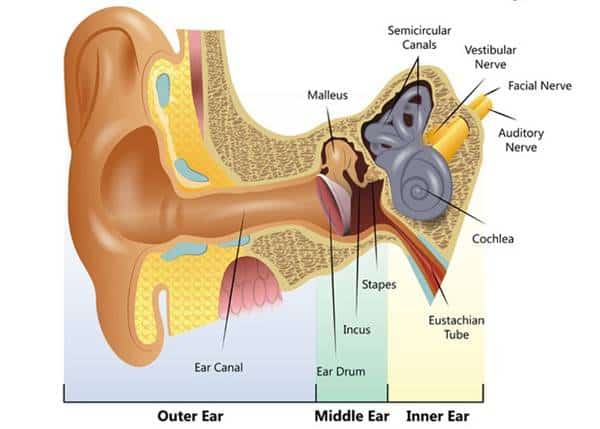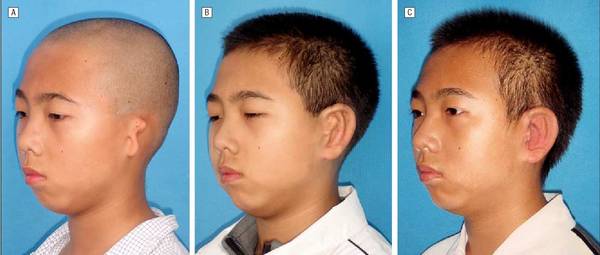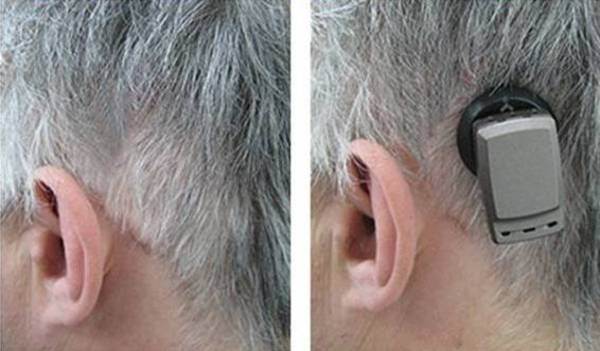Conductive hearing loss is the second most common hearing loss. The majority of people suffer from sensorineural hearing loss. Conductive deafness affects people of all age groups, unlike sensorineural hearing loss which mainly affects the elders. In most cases, it is successfully treated with medicines or surgery.
What is Conductive Hearing Loss?
Our ear is divided into three parts. The outer ear, middle ear and, the inner ear. Normally, the sound signals reaching the outer ear are transmitted to the middle ear and then on to the inner ear. This process is known as conductive hearing. In case there is any obstruction to the conductive hearing process in the outer or the middle ear, the sound waves are unable to reach the inner ear. And the person is unable to hear well, or is suffering from conductive hearing loss or conductive deafness.
Table of Contents
- What are the Conductive Hearing Loss Symptoms?
- What Are the Causes of Conductive Hearing Loss?
- Conductive Hearing Loss Treatment
What are the Conductive Hearing Loss Symptoms?
The following are the signs and symptoms of conductive hearing loss. We should be aware of the conductive hearing loss symptoms. As the success of the treatment depends on our ability to recognize the symptoms and seek immediate medical help.
- Muffled sound or loss of hearing
- A gradual reduction in hearing ability
- Earache or pain in the ear
- Dizziness
- Blocked ears or pressure in the ear

What Are the Causes of Conductive Hearing Loss?
Some of the common causes of conductive deafness are as under:
Earwax Accumulation
Not cleaning our ears regularly causes earwax to collect in the ear Canal. This causes a physical blockage. The earwax does not allow speech and sound signals to reach the eardrum. This is known as cerumen impaction conductive hearing loss.
Obstruction by an External Object
Sometimes conductive deafness is caused by small items getting stuck in the ear. It could be beads in the case of children or cotton swabs stuck in the ear.
Ear Infection
Conductive loss can be caused by the infection of the outer ear or Otitis externa. Or the infection of the inner ear known as Otitis media.
Malformation of Outer Ear
This normally happens at birth. It is either malformation of the pinna or the ear canal. A collapsed ear canal reduces the flow of sound.
Abnormal Bone Growth
Abnormal growth of the bones in the ear canal reduces the size of the ear canal. The bony obstruction reduces the flow of sound to the middle ear.
Perforated Eardrum Conductive Hearing Loss
The eardrum or the tympanic membrane vibrates according to the sound waves received by the ear. A perforated eardrum will not vibrate and cannot transfer sound waves to the middle ear.
Otosclerosis Caused Conductive Loss
Otosclerosis is the hardening of one of the three bones in the middle ear. These bones amplify and transfer the sound vibrations to the inner ear. Hardening of this bone reduces the vibrations and interrupts the process of transferring sound to the inner ear.
Injury to the Ear Due to Accident
Sound signals do not reach the inner ear if there is physical damage to the outer or inner ear.
Conductive Hearing Impairment due to Benign Tumors
Tumors can grow in the outer ear, middle ear, or inner ear. These tumors are mostly benign or non-cancerous. Sebaceous cysts may form in the ear canal, this growth restricts the flow of sound and also retains earwax causing a blockage or conductive hearing impairment.
Poor Eustachian Tube Function
Our eustachian tube balances the pressure in the middle ear. A build-up of fluid or swelling in the tube due to infection will not allow equalization of pressure. This gives a stuffy or a feeling of fullness that reduces our ability to hear.
If the conductive deafness is in one ear, it’s known as a unilateral conductive hearing loss. If both the ears are affected, it is known as bilateral conductive hearing loss
Conductive Hearing Loss Treatment
In a majority of the cases, conductive hearing loss is reversible or can be corrected. People suspecting hearing loss should not delay in consulting the doctor. Though conductive loss is reversible, neglect and delay may cause permanent damage.
Treatment for Cerumen Impaction Conductive Hearing Loss
Earwax is nature’s system of keeping our ears clean. Earwax restricts dirt from getting into our ears, keeps the ear canal lubricated, and throws out dead skin. Though ears don’t have to be cleaned regularly, some people produce excessive earwax that requires cleaning.
In case of excess earwax, visit your doctor to avoid ear canal blockage or use home methods for cleaning earwax. Do not use Q-tips or cotton earbuds, tips can push the earwax deeper into the ear.
Remedy for Obstruction by an External Object
In case Children insert a small toy in the ear while playing, rush them to the doctor immediately. The hearing is restored after the removal of the object. At times, poor quality cotton buds leave the cotton swab in the ear causing temporary hearing loss.
Treatment for Conductive Hearing Impairment due to Ear Infection
A conductive loss is caused by an ear infection. Wet ears are one of the reasons, dry your ears after a shower or a swim. Read how to prevent ear infections.
Treatment for Malformation of the Ear

Surgery can correct the malformation of the external ear. Reconstruction surgery to correct abnormalities like absence of the pinna is possible. Absence, incomplete development of the outer ear, or deformation is known as Aural Atresia. A collapsed ear canal can also be reconstructed, this deformity is known as Microtia.
Perforated Eardrum Conductive Hearing Loss
Our eardrum or the tympanic membrane is a thin semi-transparent film that vibrates according to the sound wave. It transmits sound from the outer ear to the inner ear. If this membrane tears or develops a hole, it will not vibrate and transmission of sound cannot take place.
A process known as Tympanoplasty can patch up this tear. The doctor grafts a small piece of our tissue to seal the perforation.
Treatment for Conductive Deafness due to Otosclerosis
Conductive deafness due to otosclerosis is caused by an abnormal growth around the stapes which is one of the three bones in the middle ear. This abnormal growth does not allow the stapes to vibrate and conduct sound. The surgery known as Stapedectomy replaces the stapes with a prosthesis (artificial part).
Treatment for Benign Tumors
Surgical removal of the tumour or radiation is one of the treatments. The hearing ability returns to normal once the growth is removed. A slow-growing non-cancerous tumour formed on the nerve (Acoustic neuroma) leading from the inner ear to the brain can also cause balance and tinnitus issues besides hearing loss.
Treatment for Poor Eustachian Tube Function
Eustachian tube dysfunction or poor Eustachian tube function is due to the swelling in the Eustachian tube. The dysfunction can be treated non surgically or surgically. Non-surgical methods include exercises like yawning, swallowing, or chewing.
In case, the exercises do not help, the doctor will prescribe decongestants, antibiotics, or steroids depending on the medical history. Surgical methods include enlarging the Eustachian tube by removing the extra tissue growth if any or inserting a tube to equalize the pressure.
Bone Anchored Hearing Aid for Conductive Hearing Loss
Bone Anchored Hearing Aid or BAHA is used as a conductive hearing loss treatment. The BAHA is surgically implanted in the mastoid, the hard bone behind our ear. The Implant picks up the sound, processes it, and transfers it to the inner ear through our skull. Effectively it bypasses the outer and the middle ear.

Conductive Hearing Loss is treatable and reversible in most cases. One should be aware of the symptoms and seek timely medical help.
Read our blog on What is Hearing Loss? All FAQs Answered for all your queries on the topic of hearing loss.
Reference:
https://www.enthealth.org/conditions/conductive-hearing-loss/
https://www.ncbi.nlm.nih.gov/books/NBK262265/
